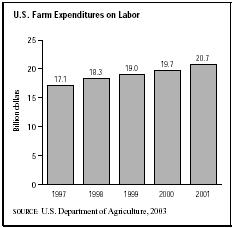SIC 0761
FARM LABOR CONTRACTORS AND CREW LEADERS
This category describes establishments primarily engaged in supplying labor for agriculture production of harvesting. Establishments primarily engaged in machine harvesting are classified in Industry 0722 (see SIC 0722: Crop Harvesting, Primarily by Machine ).
NAICS Code(s)
115115 (Farm Labor Contractors and Crew Leaders)
Roughly 500 farm labor contractors were in operation in the United States in the early 2000s. This industry is heavily concentrated in the western United States, particularly in California, where nearly 33 percent of hired agriculture workers were employed by farm labor contractors as of 2003. Farm labor contractors and crew

leaders overcome language barriers and handle paperwork as they recruit, hire, fire, supply, pay, and transport workers for the U.S. agriculture labor market. Contractors are required by law to ensure that all employees performing under their administration are certified in accordance with federal regulations, and are legally responsible for all violations. In general, U.S. farms spent a total of $20.7 billion on labor in 2001, a figure that includes contract labor expenses, compared to $17.1 billion in 1997.
Observers have long levied a variety of criticisms at farm labor contractors, most of them stemming from contractors' heavily reliance on migrant labor, including illegal immigrants. The percentage of farm laborers who were migrant workers, a classification that includes all agricultural workers who must travel such a distance as to make it impractical to return to their residence the same day, fluctuates from about 6 percent in the winter months to about 12 percent in the summer.
One of the most frequent criticisms aimed at farm labor contractors (FLCs) and crew leaders is the allegation that they allow growers to sidestep labor laws. Critics say many FLCs short workers on pay, or extract profits from workers for such things as tool rent, transportation, and lodging. Further, critics say, FLCs contribute to worker poverty, income inequality, poor conditions, a regular influx of new undocumented immigrants, and decline of the farm labor movement.
Criticism may be merited. Between July of 2003 and February of 2004, the Department of Business and Professional Regulations conducted 21 inspections of Florida citrus groves, uncovering a total of 257 labor violations in that state alone. Particularly in the FLC-heavy California, the dependence on illegal farm labor, most notably from previously untapped regions in Mexico, has skyrocketed to an estimated 43 percent of hired farm workers. The increasing use of illegal immigrants has not abated despite a number of federal actions aimed at reducing the number of such immigrants entering the United States. In all, about 90 percent of such workers at the turn of the twenty-first century were from Mexico, 80 percent were men, and 75 percent earned less than $10,000 per year. To stem the tide of illegal farm labor, state and federal legislatures have made moves to implement "Alien Agriculture Worker Programs," which compel farm labor contractors to become officially sanctioned by their state government to hire "guest" workers for a given period each year.
Contractors insist they've been unfairly criticized. An advocacy group, the National Farm Labor Contractors Association, established in 1967 and based in Fresno, California, lobbies lawmakers on behalf of FLCs, gives legal advice, and provides training, a newsletter, phone numbers, and reference materials. In 2002, several California lawmakers introduced a series of bills, part of the California Agricultural Relations Act, designed to increase the bargaining power of roughly 500,000 field workers. The passage of these bills in the fall of that year prompted the United Farm Workers of America to launch their largest organizing effort in twenty years. Given the size of California's agriculture industry, estimated at $27 billion, the movement is expected to potentially impact the entire U.S. agriculture industry.
Nationally, labor use on farms and ranches has changed dramatically since World War II. In 1950 nearly 10 million workers were employed on farms and ranches, but by 1969 this figure had been reduced to roughly 3 million. In subsequent decades, this number continued to drop and held at less than 1 million in the early 2000s. This decrease was the result of the trend toward fewer and larger agricultural enterprises and the increasing use of technological innovation. One result of increasing concentration and the development of very large farming enterprises has been the switch from family labor to the increased use of temporary workers. In the early 2000s, roughly 20 percent of all farms relied on contract labor, a sizable increase from 1980, when only about 2 percent did. Another result has been higher than average unemployment rates among farm laborers. In 2002 roughly 11 percent of the hired farm labor force was unemployed, compared to an average of roughly 6 percent for the U.S. labor force as a whole.
California is home to most of the largest FLCs in the nation. The largest was Valley Pride, Inc. of Castroville, California, with $22 million in annual sales and 400 employees. Also based in California was Tara Packing in Salinas, with $21 million in annual income and 600 employees. Other major FLCs include Vegpacker, Inc. of Yuma, Arizona, with sales of $7 million and 250 employees; Emco Harvesting of Yuma Arizona with $18 million in revenues; and 5A Harvesting Co. of Labelle, Florida.
Further Reading
"Proposed Farm Worker Pact Fuels Conflict Among Farmers, Workers." Food Institute Report, 30 September 2002.
"State Cites Farm Labor Contractors at Local Groves." Palm Beach Post, 5 February 2004.
U.S. Department of Agriculture Economic Research Service. Farm Labor: Employment Characteristics of Hired Farmworkers, Washington, DC: 13 November 2003. Available from http://www.ers.u8sda.gov/Briefing/Farmlabor/Employment/ .
Comment about this article, ask questions, or add new information about this topic: